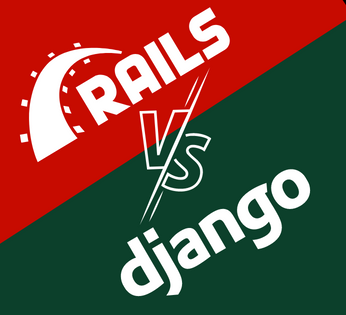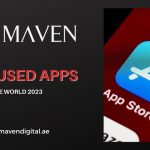There is an array of different web development frameworks for programming. But Ruby and Django beat all others. The reason? Ruby and Django are mature programming languages that are globally used and have a supportive community. Both have a reputation for a robust foundation of any app development solution.
Many times, a business chooses a web development framework based on its development team’s expertise and experience. Your chosen framework will affect your product’s performance, maintenance costs, and development resources.
Many brands first compare the features of Ruby on Rails and Django before picking one for their project. A suitable framework makes the development process more efficient and the product highly performant.
As we are in the mobile app development industry for a decade now, we have some pearls of wisdom for you if you are unsure about the best programming language to attain your organization’s goals.
Django VS Ruby on Rails: Which is Best?
We will make a head-to-head comparison between Ruby on rails and Django but first, let us throw a checklist in which we briefly review both frameworks and their core differences.
Language
Django is a web framework based on Python programming language, while Ruby on Rails uses Ruby as its programming language.
As far as the programming languages are concerned, Python has a convenient learning curve due to its straightforward syntax, while Ruby has a super flexible interface.
Design Architecture
Django follows MVT (Model-View-Template) design, while Ruby on Rails uses MVC (Model-View-Controller).
License
Rails functions under a low-limitation type of documentation for open-source software called the BSD license, which doesn't specify requirements for redistribution.
However, Django follows the MIT license that gives permissions and compensates professionals for future use.
Learning Curve
Python Developers may find it easier to use Django. RoR has a seamless learning curve thanks to its adaptable interface.
Speed
RoR is quicker by 0.7% in comparison with its rival, Django.
Scope in Web Development
Developers of Django created it to build data-heavy sites, along with ML solutions, AI projects, and Data Science. And developers created Rails for e-commerce, MVPs, meta programming, and web projects.
Flexibility
RoR is more adaptable for development, enabling users to unlock their creative sides. Django has strict creativity as compared to Ruby on Rails.
Popular Websites
Shopify, Netflix, and GitHub are some examples of sites built on Rails, while dropbox, youtube, and Disqus are famous sites that use Django.
Philosophy
Ruby on Rails believes in giving importance to growth and experimentation over stability and coding conventions over architecture.
Community Support
Highly experienced and hardworking developers may prefer RoR because of its adaptability. Django is loved among common developers due to its simplicity and thus has an active user base.
Now we know the prominent differences between these two, which is suitable for your specific software/ app project? Our next section assesses the benefits of both frameworks to help you choose one as per your needs.
When Should You Go for Django?
If you have these requirements for your project, then use Django:
- Sophisticated web applications with artificial intelligence and machine learning features
- Highly secure sites
- Mathematical and scientific programming
- Big development team
- Using big data or an enormous database
When Should You Go for Ruby on Rails?
If you have these requirements for your project, then use RoR:
- Rapid prototyping
- Fast MVP development
- Scalable sites with instant upgrading
- Secure web apps for online retailers
- Top-notch efficiency and simplicity to use
What are the Purposes of Ruby on Rails and Django?
Ruby on Rails might be an ideal substitute for back-end web apps, prototype development, MVPs, and projects that demand instant updates and scalability.
For this reason, Rails is primarily utilized for rapid prototyping, small companies, and new businesses that can grow and nurture themselves in the long- haul.
Moreover, developers use ruby on rails alongside famous client-side platforms and resources like React, Angular, or Vue. RoR is super flexible, unlike its alternatives, letting users tweak the functionality of the solutions built.
Let's talk about Django. Users have mainly employed it to build powerful and huge web apps, sites, and large databases with the help of cutting-edge tools and technologies like AI or ML.
Usually, app developers apply Django in sophisticated software that demands scientific programming, math-intensive, and significant worker input.
The Django framework is also perfect for catering to the Rest of the APIs, along with various data analysis and visualization projects.
Ruby on Rails Versus Django: What is the More Commonly Used Platform?
Both frameworks are about two decades old, but Django is more popular thanks to its simplicity.
StackOverflow surveyed 42,000 participants and found — 14.2% of developers prefer Django while only 7% use Rails. Statista testified to the results produced by StackOverflow.
Plus, more than 381,000 sites worldwide are developed using Rails as of March 2021. (Source: Foxsoft). While only 83,000 websites are built on Django.
Regardless, both platforms show similar retention rates and growth and feature an almost equal industry share within the target market. Currently, RoR boasts a market share of 27%, while Django has 28%.
What is Similar Between Ruby on Rails and Django?
Rails and Django are utilized for the server-side development of multiple web applications. Both are powerful backend frameworks, feature the highest performance benchmark, and share a diverse array of superb functions.
Everyone talks about the protection measures, incredible database support, and an identical method of building web apps. Let's discuss more of their differences.
Communities
Both frameworks and their languages have enormous user bases. It means developers can get assistance when identifying certain bugs, undesirable or unexpected actions, or other related circumstances.
The best part is that you can find help online through several examples, suggestions, and solutions.
Language Version Management
Rails and Django shares another remarkable feature, environment control, which allows the execution of several projects simultaneously. You probably know that Ruby and Python languages are both singular, but each has many versions.
You can destroy your hard work if you don't switch languages when you need to shift from one project to the other.
Fortunately, several version managers can aid you in solving this problem. Python community typically implements pyenv, and Ruby experts may opt between rbenv and rvm.
A Variety of Libraries
Django and rails both support plenty of libraries, which are called “packages” in Django and “gems” in RoR. the setup process and syntax are very similar.
Suppose you have to include user authentication in the project, then:
Use for Django:
The ubiquitous pip install command – pip3 install Flask – Authorization in your terminal. You may also run it after adding it to your requirements file.
Use for Ruby on Rails:
Gem ‘device’, ‘~> 4.7’, ‘>= 4.7.3’. Add it to your RoR gemfile. Execute the command of the Bundler tool (bundle install) in your terminal
Other similar Characteristics
Ruby on Rails and Django share useful qualities on which many developers place a high value across the world. Some of them are as follows:
- Dynamic type
- Open source
- Late binding
- Super extensible
- Syntactic sugar
- General-purpose
- Free
Difference in Architecture
Ruby on Rails features Model-View-Controller (MVC) pattern, which displays database data like pictures, comments, posts, etc. MVC is known to be a top design architecture because it easily distinguishes business logic from the UI-UX code, queries, and database.
As for Django, it follows Model-View-Template (MVT), which interprets a database that describes data structure. Django doesn't require users to program all the control-specific functions, as the controller is automated.
Bottom Line
We hope you like our comparison of the two top-notch web app frameworks — Ruby on Rails and Django. You should consider your web app’s demands and business goals before you pick a framework.
Maven Digital is an acclaimed mobile app development company. We have been working for a diverse clientele, helping brands reach new heights of success.
We have a team of incredible professionals who work diligently to exceed your expectations. Contact us today if you want your business to succeed!
FAQs
1- What is Django?
Django is a free, open-source, high-level python framework that makes it more convenient for developers to create web applications faster and with simple coding. Django supports fast development and practical, neat design.
2- What is Ruby on Rails?
Ruby on Rails is an open-source, full-stack web application development framework that helps developers compress the complexity of the latest web applications. It uses the Ruby programming language, which is one of the reasons professionals try to learn Ruby.
3- Can we compare Ruby on Rails Versus Ruby?
Yes. Ruby on Rails is a web app framework, while Ruby is an object-oriented interpreted programming language. It has over 7 versions, and the latest is 3.1.0.
RoR is written in the Ruby programming language created way before Ruby on Rails came along.
4- Why is Django known as a loosely coupled web framework?
Django is called a loosely coupled framework since it follows the Model-View-Template (MVT) pattern, an evolved form of MVC architecture.








